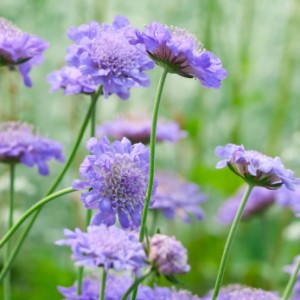Scabious
Scabious is better known as scabiosa, the butterfly blue or the pincushion flower. It produces large numbers of blue flowers that resemble pins stuck in a pin cushion. It is popular as a garden flower as it produces a lot of nectar, which effectively attracts butterflies and bees.
Description
This is a long-stemmed flower with an abundance of pin-like florets within a one-and-a-half-inch diameter bloom on top of a wiry stem that may grow between one and two feet high. It has thin, knife-like leaves of a grey-green colour and its roots can grow to around eight inches.
Habitat
The scabious is found in Europe and Asia. They have been cultivated since 1800, when they were brought from Hungary and Mediterranean Russia. In its native habitat, scabious grows on calcareous soils, chalk pits and sheep-grazed pastures. In a garden, it thrives in soil that is well drained and warm, preferably more dry than damp. It prefers a neutral to alkaline soil, mostly sand or clay loam.
Availability
The plant flowers between July and September and grows well in a rock garden or in a container. New scabious plants can be created by dividing the existing plant every few years in early spring or summer. If you need more plants, take cuttings in the summer.
Species
The species scabiosa is a genus of the teasel or Dipsacaceae family of flowers and shrubs. Teasels are recognised by their prickly leaves and stems with lavender, purple and blue flowers. These are native to temperate climates and are found throughout Europe, North Africa and Asia.
Care Tips
Scabious should be planted where it will receive full sunlight. The best time to sow from seed is just after the last frost of the winter. Perennial scabious may be sown in spring or late autumn. The flowers will grow continuously if dead-headed. The wiry stems need staking if grown in a windy area.
Did you know?
A single field scabious plant can produce around 2,000 seeds and the seeds can remain in the soil for a number of years.
References
http://www.bbc.co.uk/gardening/plants/plant_finder/plant_pages/838.shtml
http://www.backyardgardener.com/plantname/pda_9175.html
http://www.lacombecounty.com/index.php?option=com_content&view=article&id=111:field-scabious&catid=192:envirservicesweedcontrolnoxious&Itemid=277



